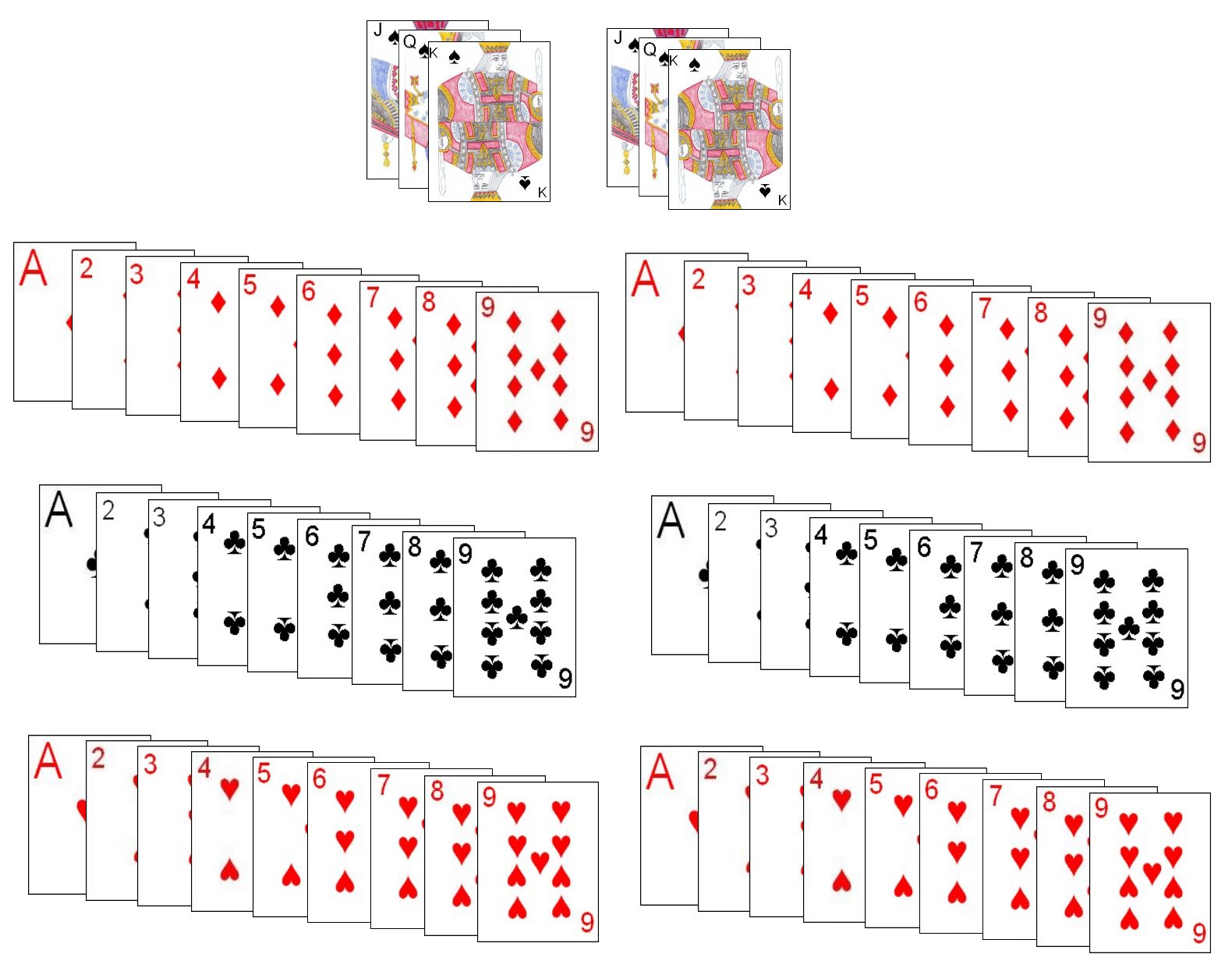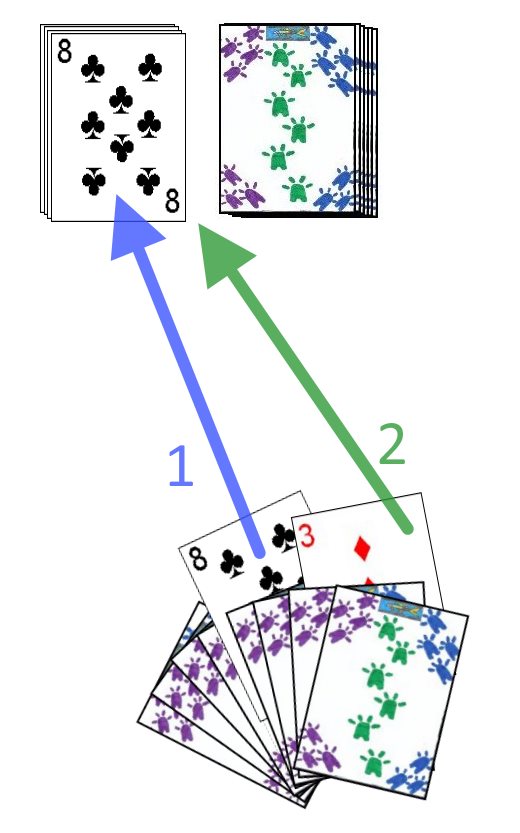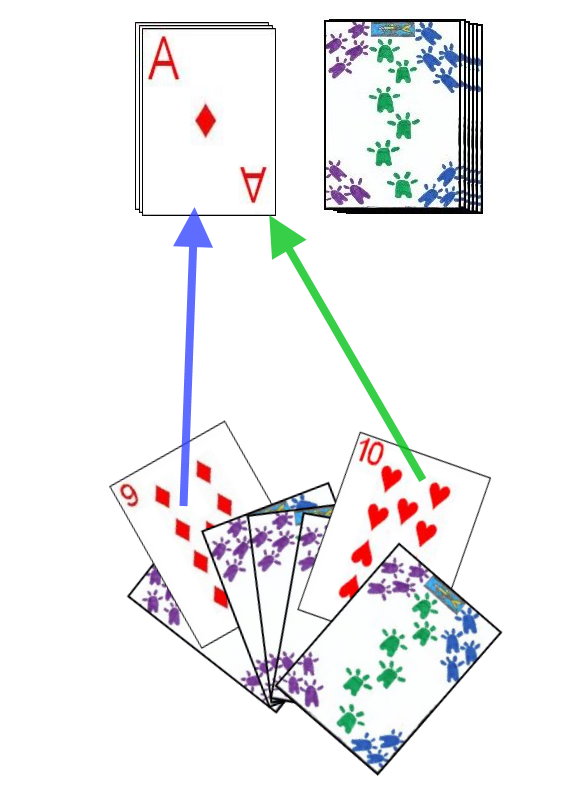Sampan is an easy to play Chinese card game. The game is named after the Sampan, a small Chinese boat that is usually powered by a sail or a pair of oars. The game is often played by children, due to it's basic rules, however it can also be a pleasant pastime for players of all ages.
The game uses a rather unusual deck which is created using two standard decks. This deck is thus comprised of the Jack of
Spades, Queen of Spades, and King of Spades from both Decks, and the Ace, 2, 3, 4, 5, 6, 7, 8, and 9 from both decks in the suits of
Clubs, Hearts and Diamonds. This will result in a deck consisting of exactly 60 cards. The cards in this deck have no relative ranking as the main object will be to play a card of the same rank and suit on another such card, as will be described below.
The game is usually played by two to eight players. The number of cards dealt to each player is directly determined by the number of players in the game as per the following chart:
| Number of Players | Cards Dealt per Player |
|---|
| 2 or 3 | 15 |
| 4 | 13 |
| 5 | 11 |
| 6 | 9 |
| 7 or 8 | 7 |
|
|

|

The first dealer and seating positions can be determined in a number of ways, with
several rounds of Janken (also known as Rock, Paper, Scissors) being common, or perhaps a draw for high card from the
same shuffled deck to be used for the game (using the following ranking from high to low; Ace, King, Queen, Jack, 9, 8, 7, 6, 5, 4, 3, 2). Once this is determined, the first dealer would thoroughly shuffle the cards and offer the deck to the player at his right to cut. After the cut, the dealer would then begin dealing the cards, one by one in a clockwise direction around the table, starting with the player to his immediate left. All cards should be dealt face down in front
of the players. He continues dealing until each player has the appropriate number of cards as per the chart above. Once each player has the requisite number of cards he then places the remainder of the deck face down in the center of the table as the stock. He then turns over the top card, placing it face up next to the stock pile, beginning the discard pile. After this, play begins.
To start, if any player has the exact same card (in rank and suit) as the card currently displayed on the top of the discard pile, he must play it to the top of the discard pile, on top of the card currently found there. After playing this card, he may then select any other remaining card in his hand and play it to the top of the discard pile, directly on top of the previous card just played. Any player who has the card exactly matching this new top card of the discard pile must then play it to the top of the discard pile. After playing such a card he may then play any other card of his choice from his hand. This continues until either one player plays his last card to the discard pile (winning the hand) or no player has the card in hand matching the top card of the discard pile.
In the case in which no player has a card matching the top card of the discard pile, the dealer simply takes the top card of the stock pile and places it face-up on the discard pile, making a new upcard. A player having the exact same card as this newly exposed card may then resume play as before.
When a player manages to legally play the last card from his hand to the stock pile, the hand ends and that player is declared the winner. The winner of each hand becomes the dealer for the next hand.
Voller Hund: Voller Hund is an older German game which is played similarly to Sampan. The game is often played with the traditional German deck, however the game is often played with the standard French deck. In this case, the French deck is reduced in size by removing all cards of denomination lower than 7 making a 32 card deck. The ranking of the cards as found in this deck are as follows (from high to low): Ace, King, Queen, Jack, 10, 9, 8, 7. Voller Hund is designed for play by three to six players.
Any means can be used to determine seating positions (if there is any dispute) and the first dealer, with draw for high cards a common method.
After the dealer has been determined, this player thoroughly shuffles
the pack and offers it to the player at his right to cut. After the cut,
the dealer begins dealing the cards in a clockwise rotation around that
table starting with the player at his immediate left. He continues
dealing until the entire pack has been dealt out. Some players may
receive one extra card than others, which is acceptable and expected
with certain numbers of players.
After the dealer has completed distributing the entire deck, whichever player has the eight of Spades (called the Hund) plays it to the middle of the table. After playing this card, he then players any other card from his hand to the table on top of the previous card, ending his turn.
The
next player in a clockwise rotation then takes his turn. If he has a card in hand of the same denomination as the last card played, he plays that card. After playing a card of that same denomination, he then plays any other card of choice from his hand. The next player in a clockwise direction then has the same play options. If a player, on his legal turn does not have a card of the same denomination as that last played, he must take all the cards from the table except the original eight of Spades, adding these cards to his hand
and leaving the eight of Spades face-up on the table. This taking of the cards into the hand counts as that player's turn and thus the next player to the immediate left of that player then has the next turn, playing any card of his choice on top of the eight of Spades, ending his turn.
If a player manages to play his last card in this manner, he drops from the game, with the player at his left having the next turn. Once all but one player have managed to play his last card to the table the hand ends, with the last player having cards considered the loser of the hand.
Gööck: Gööck is another variant of Voller Hund which is almost identical to the standard game with just two minor differences.
The first difference is that the player who has the eight of Spades, on his turn simply plays that card to the table, ending his turn and the next turn goes to the player at his immediate left.
If, at the start of a player's turn the only remaining card is the eight of Spades (which is never picked up), he may only play by playing another Eight. If he has no eights in hand, he must simply pass that turn.
In all other aspects Gööck is played identically to Voller Hund as described above.
 Hund
Hund: This game is also played very similarly to Voller Hund, with a few differences which, however, greatly alter gameplay.
As in Voller Hund the player with the eight of Spades plays this card and then any other card in his hand on top of this card.
In this variant, each player on his turn must then attempt to play a card of the same suit as that currently found on the top of the play pile rather than the rank. If unable to play such a card, he must pick up the top card from the play pile and the turn passes to the next player at that player's left.
If, on a player's turn, the only card remaining
in the play pile is the eight of Spades, he may play any card of choice
from his hand on top of that card, which then ends that player's turn.
The game continues in this manner until one player manages to play the last card from his hand, after which the hand ends and this player is declared the winner.
Copyright © 2015 CatsAtCards.com. All rights reserved.

 The first dealer and seating positions can be determined in a number of ways, with
several rounds of Janken (also known as Rock, Paper, Scissors) being common, or perhaps a draw for high card from the
same shuffled deck to be used for the game (using the following ranking from high to low; Ace, King, Queen, Jack, 9, 8, 7, 6, 5, 4, 3, 2). Once this is determined, the first dealer would thoroughly shuffle the cards and offer the deck to the player at his right to cut. After the cut, the dealer would then begin dealing the cards, one by one in a clockwise direction around the table, starting with the player to his immediate left. All cards should be dealt face down in front
of the players. He continues dealing until each player has the appropriate number of cards as per the chart above. Once each player has the requisite number of cards he then places the remainder of the deck face down in the center of the table as the stock. He then turns over the top card, placing it face up next to the stock pile, beginning the discard pile. After this, play begins.
The first dealer and seating positions can be determined in a number of ways, with
several rounds of Janken (also known as Rock, Paper, Scissors) being common, or perhaps a draw for high card from the
same shuffled deck to be used for the game (using the following ranking from high to low; Ace, King, Queen, Jack, 9, 8, 7, 6, 5, 4, 3, 2). Once this is determined, the first dealer would thoroughly shuffle the cards and offer the deck to the player at his right to cut. After the cut, the dealer would then begin dealing the cards, one by one in a clockwise direction around the table, starting with the player to his immediate left. All cards should be dealt face down in front
of the players. He continues dealing until each player has the appropriate number of cards as per the chart above. Once each player has the requisite number of cards he then places the remainder of the deck face down in the center of the table as the stock. He then turns over the top card, placing it face up next to the stock pile, beginning the discard pile. After this, play begins.
